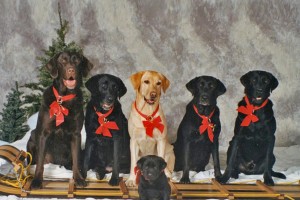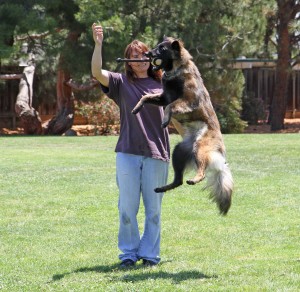Holiday Manners: Teaching a Wordless ‘Leave It’ to a Multiple Dog Crew
Originally posted December 8, 2011
‘Tis the season for food in abundance and celebration en masse. Platters are laden; counters and tables hold feasts not seen on a daily basis. Temptations are great for humans and “beasts” alike. It’s hard enough for humans to not partake in excess. Yet many people expect their dogs to ignore such culinary delights completely without giving a thought to training them for such a feat in advance.
Do you banish your crew from family gatherings that include easy access to tasty treats for fear of extreme counter surfing activities? Or do you include them, but live in fear of a guest dropping a morsel of food that isn’t dog friendly and having to move faster than you ever wanted to? Fear no more; train instead!
Teaching your dogs to leave things alone that you have not personally provided to your them is a behavior that should be a priority from day one, but it’s never too late to start. But train in advance of the need so that you and your pups are not frustrated. Until your crew’s training is perfected, practice good environmental management. This includes not leaving enticing things within reach on counters, tables, floors, etc.
Never reward your dogs in any way for jumping up on the same raised surfaces, such as with petting, verbal engagement, etc. If you drop something onto the floor that you want to give to your dogs, pick it up and hand deliver it to them rather than pointing it out to a dog or two to get. This is a good idea all around when you have multiple dogs anyway as a lone high value morsel on the floor is a recipe for a brawl in some households!
Teaching a wordless (auto) leave it takes time. How much time will vary with each dog. Some dogs have better natural impulse control than others and some dogs simply pick this up faster than others. It is imperative that you teach this behavior one-on-one with each dog prior to trying it in a group, especially if you have any guarding issues with any of your crew members!
 Wordless leave it? Yes, indeed, wordless. Do you really want to have to endlessly tell your dogs to leave things alone, especially at this time of year, when the temptations are many? Wouldn’t it be so much more convenient to have them simply do it without being asked? Indeed it would. How you achieve this is in carefully trained steps. Here they are:
Wordless leave it? Yes, indeed, wordless. Do you really want to have to endlessly tell your dogs to leave things alone, especially at this time of year, when the temptations are many? Wouldn’t it be so much more convenient to have them simply do it without being asked? Indeed it would. How you achieve this is in carefully trained steps. Here they are:
• Take a really high value treat in one hand and show it to your dog. Have more of the same treats in your other hand ready to offer as a reward. Put that hand behind your back.
• If your dog licks and paws at your offered hand to try and get the treat, don’t say anything. Simply wait for him to stop, however briefly that may be. It may take a bit and you may have to wear thin gloves to prevent your hand from getting scratched if your dog is super intent on getting the treat RIGHT NOW! Do not say anything to try to get your dog to stop, just be patient. The second your dog stops trying to get the treat or looks or backs away from the treat, even for a second, say “yes!” and offer a treat from your hidden hand. Be sure to be very enthusiastic in rewarding your dog verbally for a job well done. The timing of the marker word is important. That comes first, at the very moment that your dog makes that good decision. The treat comes after the verbal marker.
• Switch hands each time you repeat this procedure until your dogs starts looking at the hidden hand when you offer your hand. When this happens, you need to start “catching” your dog in the middle, when their attention briefly stops on you.
• Next you can place the treat inside your closed hand on a surface that is reachable by the dog. I usually start higher and then progress to a lower surface. Repeat the already described protocol, rewarding appropriately. The surface placement will make this procedure harder at first, regardless of how well your dog just did on the previous step. When your dog totally gets this step, it’s time to move on. You will likely have to practice this multiple times, in very short increments, on varying surfaces. Always take care that the reward is of equal or greater value than what you expect your dog to ignore.
• For the next step, you will place a treat inside of your closed hand on the floor. This placement is the hardest of all so be ready to move fast.You may be able to progress in one session to partially uncovering said treat while on the floor, to allow your dog to make conscious choices, being very careful that you can cover it before your dog can grasp it if he moves to take it. Remember, you will not be verbally correcting your dog at all. Your role is to mark and reward the behavior you want and only that. This needs done in very short increments to prevent frustration.
• Next you will uncover the treat even more, again taking care to be faster than your dog should you need to be. It is of vital importance that you move at the speed that your dog needs, in order to make this a solid behavior. This is not a competition. Your goal is to train this into a solidly understood behavior.
• Every success with several repetitions within an individual training session is a cue to move forward to the next step but do so only briefly. End each session on a positive successful note.
• It is important to practice this behavior in any room that it would be applicable in as well as outdoors if appropriate. It is also important to use such things that your dog might consider stealing, such as a sandwich, a piece of bread, even paper products such as paper towels, etc.
• Your goal is to progress to a point where you can toss something on the floor and have it ignored, though I would suggest that when you begin to practice with this step, you leash your dog. You will also play hockey goalie with this type of practice by placing your body between the treat and the dog, as needed. Never use the leash to separate the two, just the body language. You can also progress to simply moving your foot in front of the item or making a show of reaching for it. This will turn into a situational cue. Your guests would not know what to say to keep your dog from going after something that they dropped on the floor but they will automatically reach for it, cueing the dog that it is not theirs. You will, of course, again mark and reward your dog for the exact moment that he chooses to not go after the treat. (a hint for this particular step: use a higher value reward in your hand than the one that you are tossing)
The holidays should be a fun time for all. Training your crew to ignore yummy feasts by teaching them that they get paid well for good decisions is a win/win situation for all. Wishing you and yours a happy and safe holiday season, regardless of what holiday you personally celebrate, from me and mine.
Posted in: Projects
Leave a Comment (0) →



